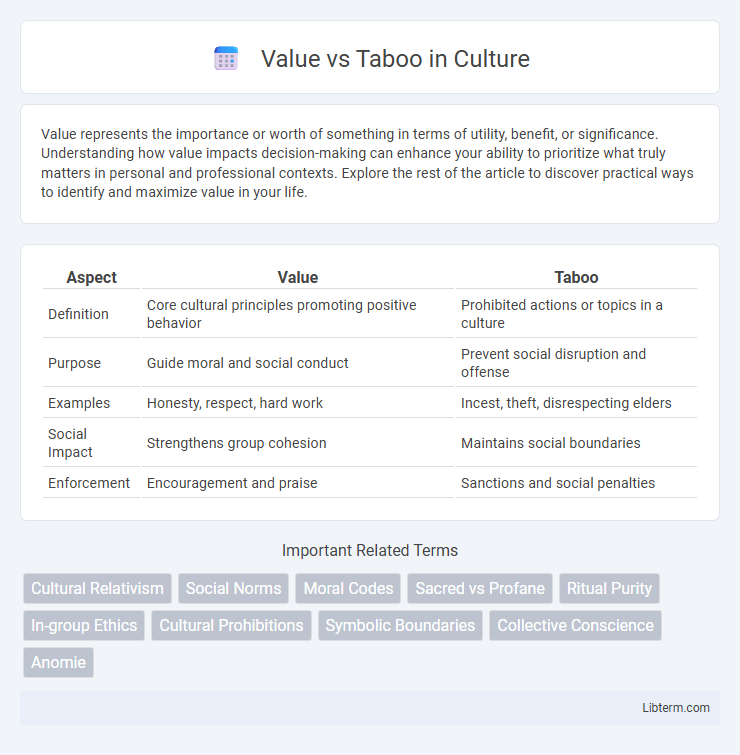Value represents the importance or worth of something in terms of utility, benefit, or significance. Understanding how value impacts decision-making can enhance your ability to prioritize what truly matters in personal and professional contexts. Explore the rest of the article to discover practical ways to identify and maximize value in your life.
Table of Comparison
| Aspect | Value | Taboo |
|---|---|---|
| Definition | Core cultural principles promoting positive behavior | Prohibited actions or topics in a culture |
| Purpose | Guide moral and social conduct | Prevent social disruption and offense |
| Examples | Honesty, respect, hard work | Incest, theft, disrespecting elders |
| Social Impact | Strengthens group cohesion | Maintains social boundaries |
| Enforcement | Encouragement and praise | Sanctions and social penalties |
Understanding Value and Taboo
Understanding value involves recognizing cultural principles that guide behavior, shaping societal norms and personal priorities. Taboo represents socially forbidden actions or topics, often rooted in deep-seated beliefs and collective identity. Analyzing value and taboo helps uncover the intricate balance between acceptance and prohibition within a community.
Historical Perspectives on Values and Taboos
Historical perspectives on values and taboos reveal how cultural norms evolve to reflect societal priorities and collective identities. Ancient civilizations, such as Mesopotamia and Egypt, embedded taboos within religious doctrines to maintain social order and reinforce hierarchical power structures. Over centuries, shifting economic, political, and religious landscapes continuously redefined what societies considered morally acceptable or forbidden, influencing modern ethical frameworks and legal systems.
Cultural Differences: What’s Valued vs. What’s Taboo
Cultural differences shape perceptions of what is valued versus what is taboo, influencing social norms and behaviors worldwide. In Japan, harmony and respect for hierarchy are highly valued, while public displays of anger are considered taboo. Conversely, in many Western cultures, individualism and direct communication are prized, and avoiding eye contact may be taboo, signifying evasiveness or dishonesty.
The Role of Society in Defining Values and Taboos
Society plays a crucial role in defining values and taboos by establishing collective norms that dictate acceptable behavior and moral standards. Cultural institutions, religious beliefs, and legal systems collaborate to reinforce these shared principles, shaping individual and group identity. The dynamic nature of social values and taboos reflects ongoing interactions between tradition, social needs, and evolving ethical perspectives.
Value Systems: Foundation of Morality
Value systems serve as the foundation of morality by providing structured principles that guide individual and collective behavior. They establish clear distinctions between what is considered good, desirable, or acceptable, forming the basis for societal norms and ethical decision-making. These systems influence not only personal conduct but also the development of taboos, which enforce boundaries by prohibiting actions that violate core values.
Social Impact of Taboos
Taboos shape social behavior by delineating permissible and forbidden actions, reinforcing collective norms and cultural identity. Violations of taboos often lead to social stigmatization, marginalization, or legal consequences, thereby maintaining social order and cohesion. The social impact of taboos extends to influencing moral values, power dynamics, and group solidarity within communities.
When Values Clash with Taboos
When values clash with taboos, individuals face intense ethical dilemmas that challenge cultural norms and personal beliefs. Such conflicts often arise in multicultural societies where diverse value systems intersect, leading to debates over what is acceptable behavior. Navigating these tensions requires critical understanding of social context, respect for differing perspectives, and adaptive communication strategies to reconcile opposing viewpoints.
Navigating Gray Areas: Changing Values and Taboos
Navigating gray areas of value versus taboo requires understanding that both are socially constructed and evolve over time through cultural, historical, and generational shifts. As societies progress, behaviors once deemed taboo may gain acceptance, reflecting changing moral frameworks and collective priorities. This dynamic interplay challenges individuals and communities to continuously reevaluate norms and adapt ethical boundaries accordingly.
Case Studies: Value vs Taboo in Modern Contexts
Case studies in modern contexts reveal how values and taboos shape societal behavior and influence decision-making processes. For example, in the realm of biotechnology, the value placed on innovation often clashes with taboos surrounding genetic modification and cloning. These cases highlight the dynamic tension between ethical values promoting progress and cultural taboos preserving traditional norms, affecting policy development and public acceptance.
Future Trends: Evolving Values and Diminishing Taboos
Future trends indicate a shift in societal norms where evolving values increasingly challenge and diminish traditional taboos, fostering more open and inclusive cultural landscapes. Digital communication and globalization accelerate this transformation by exposing diverse perspectives and facilitating dialogue on previously sensitive topics. Market research highlights growing acceptance of issues such as mental health, gender fluidity, and sustainability, marking a decline in stigmatization and a rise in progressive social values.
Value Infographic

 libterm.com
libterm.com